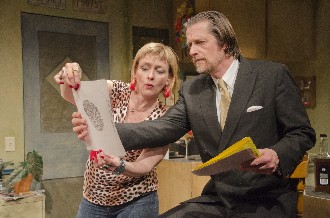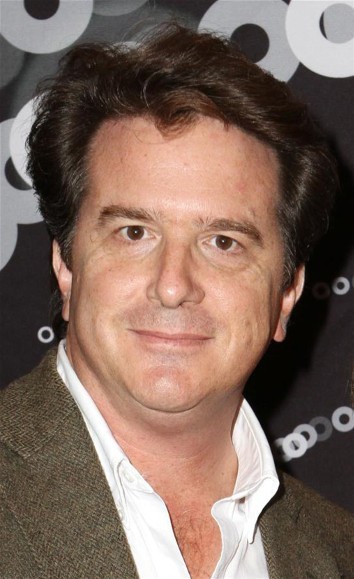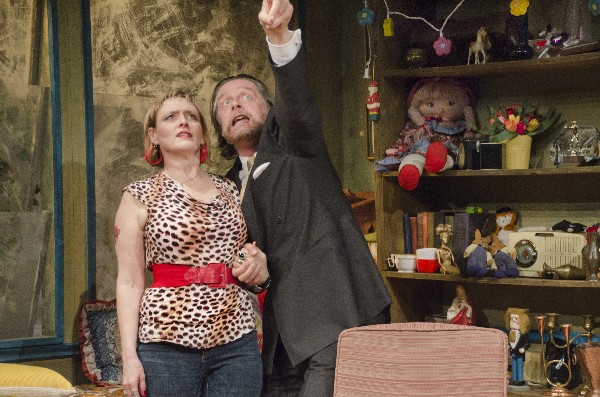Fuse Theater Interview: Ken Cheeseman on “Bakersfield Mist”
We’re in this virtual reality age now, asking new questions about what art is. What has true meaning and what doesn’t?
Bakersfield Mist by Stephen Sachs. Directed by Jeff Zinn. With Ken Cheeseman and Paula Langton. Staged by the New Repertory Theater at the Arsenal Center for the Arts, Watertown, MA., through March 18.
By Tim Jackson
Bakersfield Mist, currently at the New Repertory Theater (New Rep) in Watertown, MA, is the third of a trio of recent Boston productions dealing with the subject of art in general and painting in particular. In John Logan’s, Red, the painter Mark Rothko gives his young apprentice, and the audience, a passionate discourse on art and inspiration. In Art, by Yasmina Reza, the disagreement among three men over the value of a white painting nearly comes to blows.
Bakersfield Mist, a two-character play directed by Jeff Zinn and featuring Ken Cheeseman and Paula Langton, is about Maude Gutman, a poor, slightly broken down, hard-drinking, working-class woman who buys, as a joke, what she thinks is the ugliest painting she can find in the local thrift store. She’s told that it might possibly be worth millions, an undiscovered Jackson Pollock, an artist with whom she is far from familiar.
Maude sends for the erudite Lionel Percy, a renowned, New York art expert of much repute to verify its authenticity. And here the play begins. Overtly it is about class difference and attitude, but larger themes emerge on the spiritual value of art and the relativity of truth.
The play obliquely references several actual stories, particularly that of an alleged Jackson Pollack painting purchased for $15 in a thrift store in 1992 by a woman named Teri Horton. Her story is documented in the film Who the [Bleep] is Jackson Pollack?
Playwright Stephen Sachs pares the story down to two characters. He sets all the action in a single location, Maude’s trailer, and restricts the time to the 80 minutes we spend in the company of these two mismatched individuals. With this classical structure, and under the direction of Jeff Zinn, the play explores a range of themes on the value of art and the quirkiness of human experience.
I spoke with Ken Cheeseman to discuss the genesis of the production, the ideas in the play, and how he sees his character of Lionel Percy.
Arts Fuse: I know this production was originally produced at the Wellfleet Harbor Actor’s Theatre, and early on you seem to have found a nice rhythm to the play.
Ken Cheeseman: It was on a kind of repertory schedule with another play in Wellfleet. We didn’t have a huge number of performances but we started to find the rhythm there. It’s been five months now since we did it on the Cape. I am the kind of a person who after I walk off stage completely forgets what I was doing in last play. We did have to re-find the play and re-find ourselves in this new space. But that was good, because it made it fresh and kept it alive. We had a week up here to put it together again, and we like this new space. It feels intimate and in a way, like an installation piece, as though we dropped a trailer into a small room and invited a bunch of people to peak in through the windows.
AF: It’s interesting to see this play following the recent productions of Red and Art. All of these plays discuss ideas of art and authenticity.
Cheeseman: I think that sometimes a kind of collective unconscious is at work. Certainly there is in terms of the themes and topics that inform the plays we do. For me personally, I have these theories about the twenty-first century and our relationship to reality being altered. It’s something that started in the 1940s with the atomic bomb and Japanese director Akira Kurosawa and Samuel Beckett, who were looking at life from a different perspective, looking at reality as being somewhat relative.
Now we’re in this virtual reality age asking new questions about what art is. What has true meaning and what doesn’t? I think that’s one of the reasons why plays on this topic are in vogue right now. These are questions that we are collectively asking.
AF: We’re clawing our way out of the simulacrum.
Cheeseman: Yeah. That’s true.
AF: How much of the play is based on the story of Teri Horton documented in the film Who the [bleep] is Jackson Pollock?
Cheeseman: I think that story was the kernel for the playwright’s inspiration. But there are layers that Stephen (Sachs) added to it. We know that these two people are from two different worlds and are going to be trapped together in his trailer for 80 minutes. It’s going to be interesting just watching them try to coexist in this small space. What makes us up as human beings is more than our class differences. Once class falls away, we get down to the more core elements of people as individuals. Once we find our common ground, then we find the real differences. I think that’s what unfolds here.
AF: Lionel at one point references the word ‘arête’, which he says is the Aristotelian notion of “the true, the beautiful and good, and of courage and strength in the face of adversity: virtue without flaw,” and that suddenly becomes a theme. Once that idea is raised the play shifts.
Cheeseman: Yes, there are a few shifts. There’s a shift that leads to that moment. And that shift occurs when I’m seeing the painting and I’ve made my decision but she wants me to stay because she wants me to say the painting is real. She’s had an experience with a painting that she needs to understand. She needs a context. She needs to know why she has this relationship with his painting. The painting means more to her than just his ugly thing that she bought as a joke. It’s grown on her. She’s had this experience, and she needs know what that is. I start to sense that she’s got that going on, and it keeps me there are as well. That’s where we start to find a common ground, which is the relationship to the art -— art being something meaningful and true, something beautiful and good. It is a kind of Aristotelian definition of what art is.
AF: At that point we realize that the conflict may not be simply about money.
Cheeseman: Right. It becomes about being verified and having value as a human being.
You know for performing artists, or writers, or painters, it is easy to fall into the cultural trap of thinking what you do doesn’t have the same kind of pragmatic value or practical meaning that other people have with their jobs.
There’s this tale of an actor at a party. One man says, “I’m a brain surgeon and I save lives every day doing brain surgery.” Another says, “I’m a judge and I make all these life or death decisions, about prison or no prison.” They look at the actor and say, “What do you do?” And he says, “Well, I’m an actor, and I make their lives worth living.”
It is art that gives us some context and meaning for why we’re here. Those basic elements are what these two people in the play get down to.
AF: The book Blink begins with the same moment that Bakersfield Mist begins with -— this is the “blink” moment experienced by Thomas Hoving, as I recall.
Cheeseman: Ah ha. That’s the same question I asked of Stephen. We take the story of Hoving seeing the statue, and we reverse it in this play.
Now we’re talking about a statue that was in the Getty Museum in Malibu. I’ve actually seen the statue; it is a kouros [as mentioned in the play], which is a big, tall statue of an ideal Greek youth. When Hoving saw that statue being taken out of its crate at the Getty Museum with a crane, he looked at it -— for about 30 seconds -— and said, “Have you paid for it yet?” And they said, “What do you mean?” And he said, “If you haven’t paid for it -— don’t.” He called it a fake.
He was vilified in the press because they said he was jealous of the Getty Museum acquiring this work of art. The Getty director refuted his claim. It was one director/curator fighting another. He was also crucified in the New York Times. But Hoving said, “You can believe me or not, but in 10 years, I’m going to be proven right.” And he was.
Now in the play, we see that Lionel Percy is following the track of Hoving, but then he shifts to the track of the director of the Getty Museum, who incorrectly said it was not a fake. [Note: This is not a spoiler! You have to see the play to understand the situation.]
AF: There is another story that this play appears to reference: the story of Todd Volpe.
Cheeseman: What was that one?
AF: Volpe did a lot of art forgeries, and he kept “finding” a tell-tale thumbprint.
Cheeseman: Oh yes, yes.
AF: And he said he was going to verify Terry Horton’s Pollack painting because he found a thumbprint. Now your character, Lionel, says, “I don’t care if you have a thumbprint; it’s still not real.” The audience might be thinking, “Isn’t that proof?” And yet your character is still denying it.
Cheeseman: Paul Biro was actually the name of the guy. He was, with Volpe, going around and finding these ambiguous master paintings and working real hard to prove they were authentic. They suspected Biro actually copied a Pollack fingerprint found on a blue can of paint and falsely pressed that fingerprint into Terry’s painting. Who knows? That’s where, as Lionel Percy, I say, “What does science know about art?” It has more to do with the aesthetic.
AF: One last question about Lionel Percy. He comes in to visit the Maude in her trailer by way of a corporate jet, yet he seems a bit dissipated. Your hair is mussed; you’re a bit unshaven. What state of mind is Lionel in?
Cheeseman: He really does not want to go to this place merely as a consulting expert, where he had been a museum director for so long. I have played him neater and more closely cropped. But I think he would really like to be Jackson Pollock. He’d like to be an artist, but he’s got this other identity that he’s had to assume and now he’s fighting that.
I think that’s part of why there is a kind of dissipation to his appearance. He’s also dealing with Maude’s dogs, the heat of Bakersfield, California, and the humbling experience and facts that this is what he’s doing with his life: He’s getting paid to go to Bakersfield look at this painting, which is very possibly a Francis Hogan Brown [a known, real-world copier of Pollack’s drip style]. There are lots of them.
AF: With a play that covers ideas not only about art but issues of class, creativity, authenticity, truth, and the spirit, what you think audiences will be talking about when they leave the theater?
Cheeseman: All of those things. One thing we noticed when did the script on the Cape, and also here, is that audiences really like to talk about the play. Audience members don’t always want to talk about a play after they have seen it. I can do a Shakespeare play, and people might say it was great and all, but then you go outside for a drink or a bite to eat, and they quickly move onto something else. But people seem to want to stay on the topic of this play. All those questions we have talked about during this conversation are the questions that people ask.
Tagged: Bakersfield Mist, Jackson-pollock, Jeff Zinn, Ken Cheeseman, art



